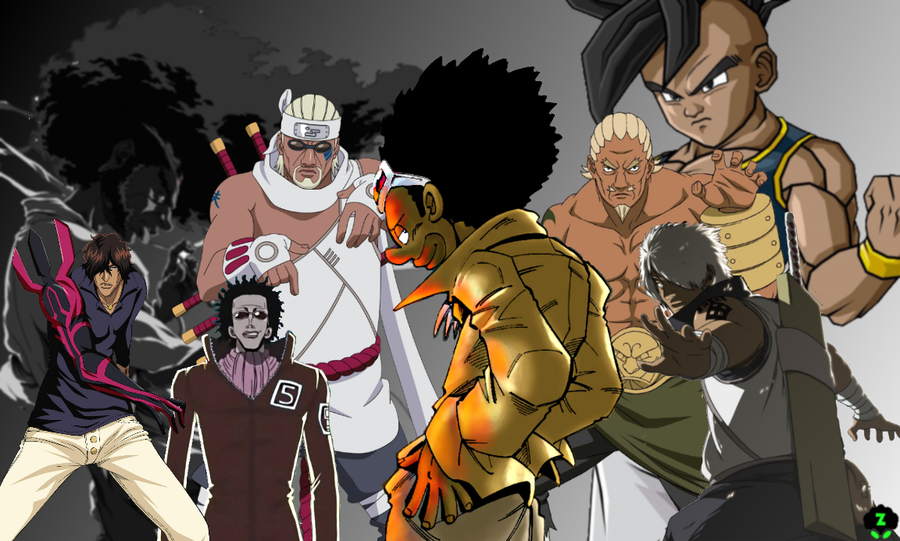Japanese Anime and Racism Blog: Wesley Matingou
The prejudiced and antiquated portrayal of persons of color in Japanese anime have contributed to and perpetuated the negative perceptions that The Japanese have about Black people. Anime and Manga are the most popular forms of media in Japan, and their misrepresentation a xenophobic and colorist ideology that affects all social realms in Japan and creates a hostile environment for persons of color in Japan. This blog post will analyze how Japanese history, early forms of anime and manga, and modern anime and manga have shaped the social sphere of Japan in regard to racism and colorism.
Japanese history has shaped the culture of Japan, and laid the foundation for its racist and colorist beliefs. For nearly 80 years Japan isolated itself from the rest of the world in an effort to keep Japanese religion and culture pure. During this period known as the Edo period, traditional Japanese beliefs were reformed leading to a Japanese renaissance. Japan’s renaissance came to an abrupt halt on July 8, 1853, when Commodore Matthew Perry of the United States Navy, commanding a squadron of two steamers and two sailing vessels, sailed into Tokyo harbor. Perry forced Japan to enter into trade with the United States and demanded a treaty permitting trade and the opening of Japanese ports to U.S. merchant ships. The sudden influx of Western influence in Japan caused dramatic changes on all forms of Japanese media. With Japanese culture being reshaped by the racist forms of US media from the late 1800’s, one can easily see how Japan’s history shaped the racist and xenophobic culture of Japan.
Earlier forms of Japanese anime and Manga were heavily influenced by Western media that was both racist and colorist. A popular form of American satire during the advent of Western influence in Japan, was blackface. Blackface is a form of satire in which a nonblack performer paints their face black and lips pink when playing a Black role. The role played is typically comedic or musical and always used to portray Black people in a negative light. Japanese culture accepted blackface and even implemented it in many popular manga and anime. Examples of this can be found in famous anime and manga such as Cyborg 009 and Dragonball Z; Both shows feature characters that are identical with the blackface characters seen in Western television shows. There are also plenty of other anime and manga that have no Black lead characters and only portray their Black characters as thugs or criminals. The direct parallels between Japanese and Western media prove how great of a racist and colorist influence Western media had on manga and anime.
Modern Japanese anime and manga has begun to shift away from the xenophobia and colorism that it was rooted in. As society has progressed these racist and colorist depictions of Blacks in anime and manga have become more scarce. There has also been a steady increase in anime and manga with Black lead characters, and a better representation of Blacks in anime and manga all around. This push for the reform of Japanese media was pioneered by the famous artist, Tezuka Osamu. Tezuka who is the creator of many famous manga such as: Astro Boy, Phoenix, and Black Jack, released a public statement in which he apologized for the racist and colorist undertones used in his earlier manga. This modern day shift away from the racism and colorism in Japanese media has began to ease the xenophobia of the Japanese society.
Today, more and more anime and manga have taken progressive steps to reform the xenophobic sentiment held by the Japanese people. This change has lead to a more inclusive and accepting sentiment shared among Japanese millennials. For example, a court ruled last month that an anti-Korean group that protested outside of a school for ethnic Koreans in Kyoto would have to pay damages, saying the activity “constituted racial discrimination” under the UN convention. In a similar case some years ago in Hamamatsu, a court ordered a jewelry shop that refused to serve a Brazilian resident to pay damages, citing the International Convention on the Elimination of All Forms of Racial Discrimination as the legal standard in the absence of a domestic discrimination law. Most importantly, average Japanese, concerned about the direction their country is taking, are speaking out. General rallies were held in Tokyo and Osaka recently to protest racism and hate speech. Similarly, when an anti-Korean protest was held in Shin-Okubo, a neighborhood with many ethnic Koreans and immigrants, counter-protesters showed up to support their Korean neighbors. These are just a few of the many examples of how Japan is now on track to achieving social reform through its most popular forms of media, which will in turn eliminate the the negative perceptions that The Japanese have about Black people.
